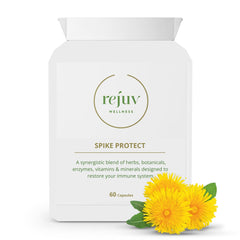At Rejuv Wellness, we believe that food is medicine, but not all produce is equal. Each year, the Environmental Working Group (EWG) releases its Dirty Dozen list. This identifies the twelve fruits and vegetables most contaminated with pesticides, even after washing or peeling.
If you are supporting detoxification, hormonal balance, gut health or graceful ageing, understanding what to buy organically is key to minimising your toxic load.
The 2025 Dirty Dozen
- Spinach
- Strawberries
- Kale, collard and mustard greens
- Grapes
- Peaches
- Cherries
- Nectarines
- Pears
- Apples
- Blackberries (new this year)
- Blueberries
- Potatoes (new this year)
Also worth noting: bell and hot peppers, along with green beans, ranked high for pesticide toxicity.
Why Are These Considered "Dirty"?
- Ninety-six per cent of samples tested contained at least one pesticide residue.
- Many samples contained four or more types of pesticides.
- Across all samples, 203 different pesticide chemicals were detected.
- Systemic pesticides, such as chlorpropham (banned in the EU), were found – these absorb into the flesh and cannot be washed off.
A Global Perspective on Pesticides
While the Dirty Dozen and Clean Fifteen lists are based on American farming practices, they still serve as a helpful guide, even for those of us in the UK, Europe, or Australia. Research shows that many of the same fruits and vegetables can contain multiple pesticide residues globally, even when grown under stricter regulations.
The genuine concern is not just a single chemical, but the combined effect of several low-level residues which can disrupt your metabolism, gut health and hormone balance.
No matter where you live, reducing your overall toxic load remains a wise and proactive health strategy.
Hacks to Redeem the Dirty Dozen (Updated for 2025)
I understand that the Dirty Dozen list might feel overwhelming, but I am certainly not suggesting you avoid these nutrient-dense fruits and vegetables altogether.
Instead, try these simple methods to reduce their toxic load and make them safer to enjoy:
1. Soak in Water and Bicarbonate of Soda
A simple home remedy to reduce pesticide residue is to soak your produce. Fill your sink or a large bowl with filtered water and add two tablespoons of bicarbonate of soda. Soak your fruits and vegetables for 10 to 15 minutes, rinse well and then store. This helps remove surface-level toxins and dirt without damaging the food.
2. Clean with Ozone
For a deeper cleanse, I use the Therasage Ozone Bubbler. It infuses water with ozone to help break down pesticide residues and pathogens in just a few minutes.
Place your produce in a sink or large bowl, run the bubbler for 5 to 10 minutes, rinse and store. It is a brilliant long-term investment for your health and costs approximately $ 100. You can use my code REJUV for 10% off at Therasage.
3. Choose Organic Where It Counts
If buying everything organic is not practical, use the Dirty Dozen list to guide your purchasing decisions. Focus on buying organic versions of high-risk items, such as strawberries, spinach, apples, and grapes. For the Clean Fifteen, conventionally grown produce is generally fine.
The Clean Fifteen: Safer Produce Choices
These fruits and vegetables had the lowest detectable pesticide residues, even when conventionally grown:
- Pineapple
- Sweetcorn (fresh or frozen)
- Avocados
- Papaya
- Onions
- Sweet peas (frozen)
- Asparagus
- Cabbage
- Watermelon
- Cauliflower
- Bananas
- Mangoes
- Carrots
- Mushrooms
- Kiwi
Smart Strategy: When to Buy Organic
| Category | Choose This | Reason |
|---|---|---|
| Organic | Dirty Dozen produce | To avoid high levels of synthetic pesticides and lower overall toxin exposure |
| Conventional | Clean Fifteen, or when organic is unavailable | These have consistently low or undetectable pesticide residues |
My Expert Insight
We examine pesticide exposure through the lens of detoxification. Our liver and gut are under constant pressure. Prioritising organic versions of the most contaminated produce helps ease that burden in a meaningful way.
How to Support Your Body Beyond the Basket
We recommend incorporating detox-supportive plants, such as spinach, kale, apples, and blueberries, into your diet, but always opt for organic options whenever possible. For additional support, consider:
- Antioxidant Support
- Liver Support
- Heavy Metal Detox
- Spike Protect – for long COVID or post-vaccine support
Want a Smarter Detox Approach?
Try our comprehensive Detox Pack, designed to support your seven pillars of wellness. It includes a complete nutritional and wellness plan to help your body manage environmental toxins.
Not sure where to start? Take our FREE Wellness Quiz and discover what your body needs most.











